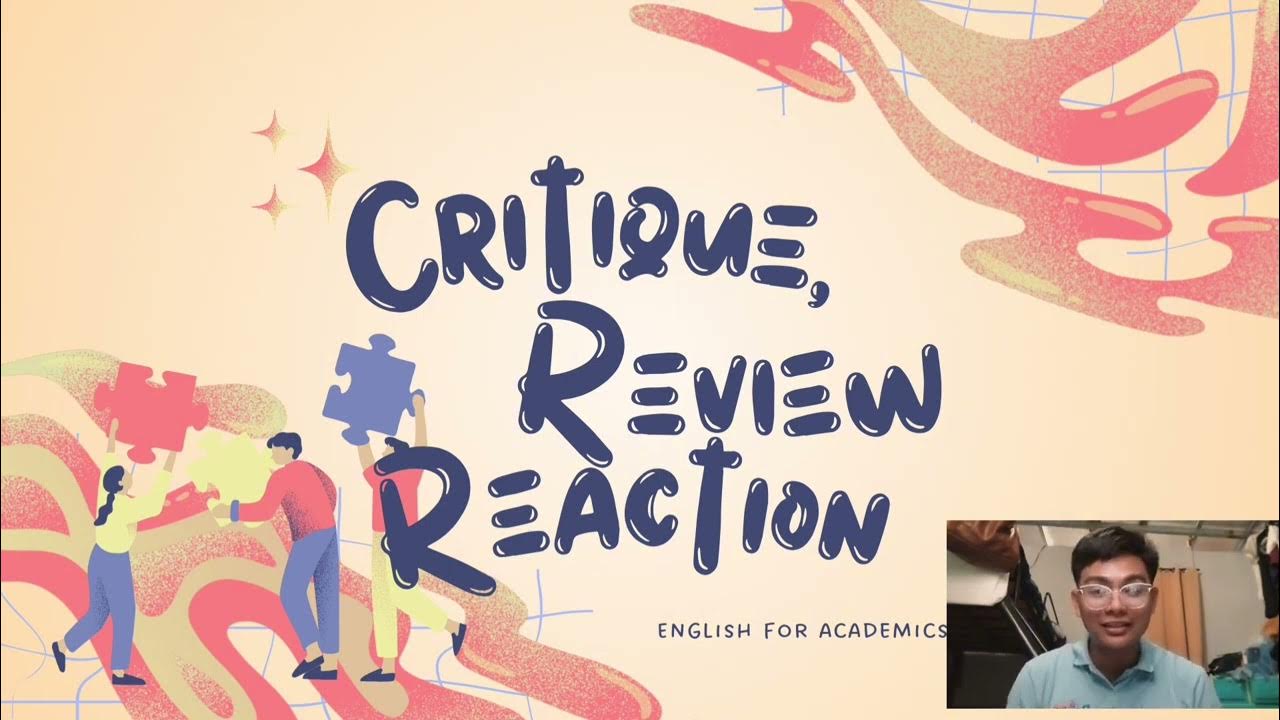How to Write a Reaction Paper
Summary
TLDRIn this educational video, Teacher Aljay guides viewers on crafting a reaction paper, distinguishing it from a reflection paper by emphasizing critical analysis and personal opinion. The tutorial covers the structure, including an introduction, body discussing points of agreement and disagreement, and a conclusion on broader significance. Key steps are outlined, such as thoroughly understanding the material, writing with coherence, and applying insights to personal life or ministry. The video aims to enhance critical thinking and academic writing skills.
Takeaways
- 📚 A reaction paper involves critical analysis and personal opinions on a reading or multimedia material, going beyond mere reflection.
- 🤔 Both reflection and reaction papers require deep thought on the author's points, but a reaction paper demands additional critical evaluation.
- 📝 The structure of a reaction paper typically includes an introduction, body, and conclusion, with specific elements to be covered in each part.
- 👀 In the introduction, mention the article's name, author, thesis statement, and provide a brief summary of the material.
- 🔍 The body of the paper should detail points of agreement and disagreement with the author, backed by reasons and examples.
- 💭 Disagreements should be respectful, acknowledging the author's context, and disagreements should be supported by strong reasoning.
- 🔑 Critical thinking is key; even if you agree with the author, look for additional insights or areas where the author could provide more detail.
- 🌟 Application involves discussing how the material impacts you personally and can be applied to your life or ministry.
- 🏆 The conclusion should reflect on the broader significance of the material for society, the church, or a larger context.
- 📈 The video provides a step-by-step guide to writing a reaction paper, emphasizing the importance of understanding, critical thinking, and personal application.
Q & A
What is the main difference between a reaction paper and a reflection paper?
-A reaction paper requires you to critically evaluate the content, points, illustrations, and style of the author's work, whereas a reflection paper focuses more on how the material personally affects you without the need for critical analysis or disagreement.
What are the typical sections of a reaction paper?
-A typical reaction paper includes an Introduction, Body, and Conclusion. The Introduction should mention the article or chapter, the author, and provide a brief summary. The Body contains your reactions, agreements, disagreements, and applications. The Conclusion discusses the significance of the material for a larger context.
Why is it important to understand the material thoroughly before writing a reaction paper?
-Understanding the material thoroughly is crucial to avoid misunderstanding the author's main points, which can lead to quoting out of context or misrepresenting the author's views. It ensures that your reaction is based on a correct interpretation of the content.
What should be included in the introduction of a reaction paper?
-The introduction should include the author's name, the title of the article or chapter, the book's name if applicable, the thesis statement of the article, and a brief summary of the material.
How should you approach writing about points you agree with in the body of a reaction paper?
-When writing about points of agreement, use direct quotations or paraphrases to mention the author's points and provide reasons why you agree, relating it to your previous knowledge, situation, or current context.
Can you disagree with the author in a reaction paper, and how should you do it?
-Yes, you can disagree with the author, but it should be done respectfully and with a clear understanding of the author's context. Provide strong reasons for your disagreement and consider acknowledging the context in which the author wrote the article.
What if you find no points to disagree with in the author's work?
-If you find no points to disagree with, consider whether the author's points are applicable in your context, offer additional points or examples, or suggest that the author could elaborate more on certain points for clarity.
How should you write the application section of a reaction paper?
-The application section should be specific, practical, and personal, discussing how the article influenced you and how it will result in a change of action or mindset.
What is the purpose of the conclusion in a reaction paper?
-The conclusion should discuss the broader significance of the material, such as its importance to society, the community, or the church, and how it might impact families or the society as a whole.
What is the main goal of writing a reaction paper according to the script?
-The main goal of writing a reaction paper is to demonstrate critical thinking skills by analyzing and evaluating the author's work, and to show how the material can be applied to one's life or ministry for personal transformation.
Outlines

Cette section est réservée aux utilisateurs payants. Améliorez votre compte pour accéder à cette section.
Améliorer maintenantMindmap

Cette section est réservée aux utilisateurs payants. Améliorez votre compte pour accéder à cette section.
Améliorer maintenantKeywords

Cette section est réservée aux utilisateurs payants. Améliorez votre compte pour accéder à cette section.
Améliorer maintenantHighlights

Cette section est réservée aux utilisateurs payants. Améliorez votre compte pour accéder à cette section.
Améliorer maintenantTranscripts

Cette section est réservée aux utilisateurs payants. Améliorez votre compte pour accéder à cette section.
Améliorer maintenantVoir Plus de Vidéos Connexes

How to Write a Reaction Paper

Writing the Critique, Review, and Reaction Paper | Lesson 2

DIY RECYCLING PAPER TANPA BLENDER ! #makingpaperathome #homemadepaper

PAANO SUMULAT NG CRITIQUE PAPER? | step by step guide (with English sub)

EAPP in TAGLISH Ep.6 - Critical Approaches in Writing a Critique

#2 How to Write the Introduction Paragraph of a Research Paper?
5.0 / 5 (0 votes)
